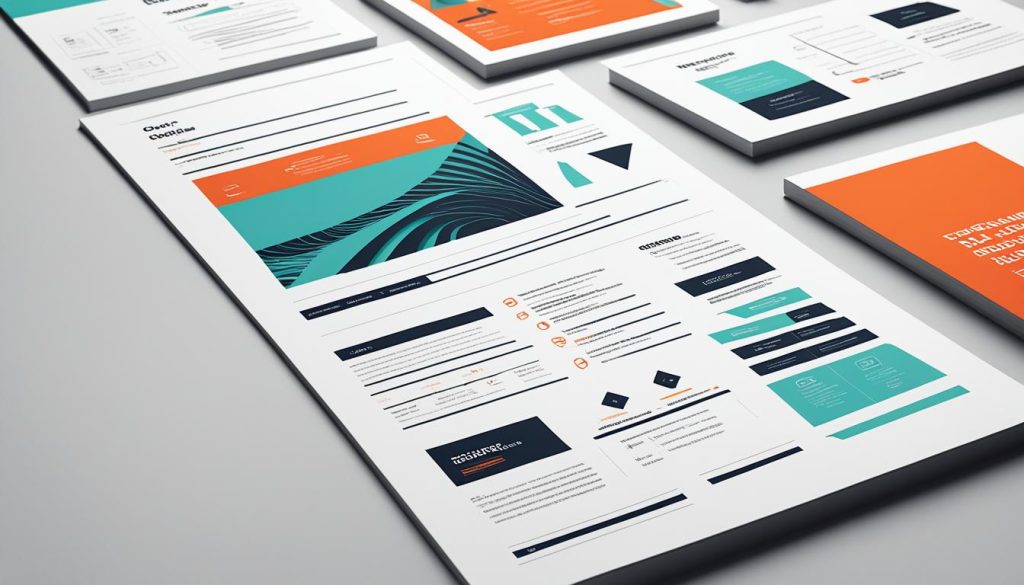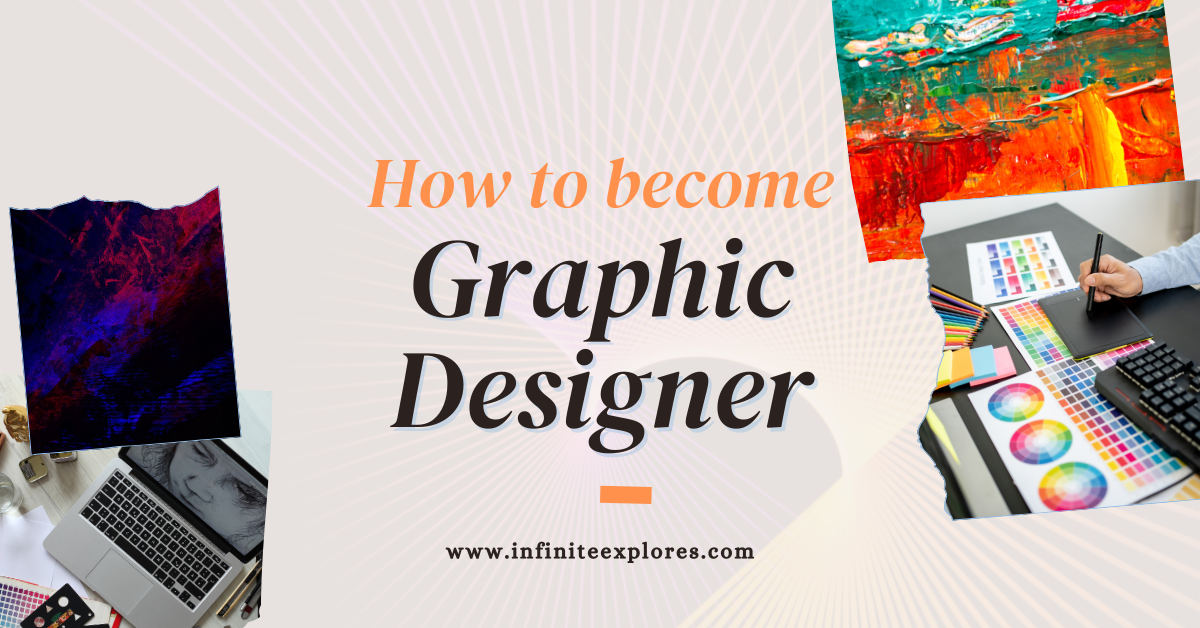Graphic design is now key in our fast-changing digital world. If you love making things look great or enjoy creating beautiful designs, a career in graphic design could be perfect for you. This guide will take you through the world of graphic design. We’ll cover what graphic designers do, what they need to know, and how to succeed in this exciting field.

Create an abstract image representing the creativity and versatility of a graphic designer, incorporating various shapes, colors, and textures to convey the designer’s ability to craft unique and visually stunning designs.
Table of Contents
Key Takeaways
- Discover the diverse roles and responsibilities of a graphic designer
- Understand the importance of visual communication in today’s digital era
- Explore the educational paths and degree programs available for aspiring graphic designers
- Develop a strong portfolio to showcase your design expertise
- Identify the essential technical and creative skills needed to succeed in the graphic design field
- Gain insights into the current and future outlook of the graphic design industry
- Learn practical tips for kickstarting your graphic design career, including networking and internships
What is a Graphic Designer?
Graphic designers make designs that grab attention and share messages clearly. They handle many tasks, like making logos and branding, and designing for print and digital media.
Roles and Responsibilities of a Graphic Designer
Graphic designers use their art and tech skills to make designs that pop. They do things like:
- Designing logos, corporate identities, and branding materials
- Creating layouts for print media such as magazines, brochures, and advertisements
- Developing user interfaces and visual elements for websites and mobile applications
- Producing illustrations, infographics, and other visual content
- Working with clients to understand their needs and make designs that meet those needs
The Importance of Visual Communication
In graphic design, how you communicate visually matters a lot. Designers use color, type, images, and layout to share ideas, feelings, and messages. This way, they grab the audience’s attention, get the right response, and make a mark.
Knowing how to communicate visually well helps designers make designs that are not just pretty but also get the message across clearly to the audience.
| Key Responsibilities of a Graphic Designer | Impact of Effective Visual Communication |
|---|---|
| Logo designBranding and identity developmentLayout and design for print mediaUser interface and web designIllustration and infographic creation | Captures audience attentionConveys complex ideas effectivelyEvokes desired emotional responsesLeaves a lasting impressionEnhances the graphic designer job description |
How to become a graphic designer
Starting a career as a graphic designer is both exciting and rewarding. It’s a great choice whether you’re new to the field or looking for a change. The journey to become a graphic designer includes several important steps. These steps cover developing skills and building a strong portfolio to start your career.
- Obtain Relevant Education: A bachelor’s degree in graphic design, visual communications, or a similar field is often needed. You’ll learn about design principles, color theory, typography, and how to use digital software.
- Cultivate Your Artistic Skills: Good graphic designers have a great sense of aesthetics and can turn ideas into beautiful designs. Work on your drawing, sketching, and digital illustration skills to make your designs stand out.
- Master Design Software: Knowing how to use software like Adobe Creative Cloud (Photoshop, Illustrator, InDesign) is key. Keep up with new tools and techniques to stay ahead in your career.
- Build a Standout Portfolio: Your portfolio is key to showing off your design skills. Put together a collection of your best work. It should show your creativity, technical skills, and how you solve problems.
- Gain Practical Experience: Look for internships, freelance work, or entry-level jobs to get real-world experience. This will help you improve your skills and make professional contacts.
- Stay Informed and Adaptable: The graphic design world is always changing. Keep up with new trends, technologies, and best practices. Be open to learning and improving your skills.
By taking these steps, you’re on your way to a successful graphic design career path. Remember, becoming a graphic designer is unique to you. The steps you take will depend on your goals and situation.
“Graphic design is the paradise of individuality, eccentricity, heresy, abnormality, hobbies, and humors.” – George Santayana
Educational Requirements for Graphic Designers
Graphic designers have many educational paths to pick from. Each path has its own benefits. Choosing the right education is key to a successful career in this exciting field.
Degree Programs in Graphic Design
A bachelor’s degree in graphic design is a popular choice for entering the graphic design industry. These four-year programs cover important topics like typography, color theory, and digital art. Top graphic design schools offer these degrees, giving students the skills and knowledge they need to succeed.
For a quicker start, associate’s degree programs in graphic design are available. These two-year programs focus on the basics, preparing students for entry-level jobs. An associate’s degree is a less expensive way to begin a graphic design career.
Some graphic design schools also offer graphic design certificates. These are for those already in the field or wanting to improve their skills. Certificates focus on specific areas like web design or branding, giving students a deeper understanding.
“The key to success in graphic design is to combine technical proficiency with a strong creative vision. The right educational program can help you develop both.”
Building a Strong Portfolio
Your graphic design portfolio is key to showing off your skills and getting your dream job. A well-made, eye-catching portfolio can really grab the attention of employers or clients. We’ll look at the key parts of making a strong graphic design portfolio that will make you stand out.
Curate Your Best Work
Quality is more important than quantity in your graphic design portfolio. Pick projects that show off your design skills, creativity, and problem-solving. Aim for 10-15 pieces that cover a wide range of your expertise, like branding, print design, digital interfaces, and packaging.
Highlight Your Design Process
Don’t just show the final designs; tell the story behind them. Include sketches, mood boards, and other process documents to show your creative thinking. This shows your design skills and how you solve complex problems.
Optimize for Digital Presentation
Your graphic design portfolio should be easy to find and look great online. Use a professional website or portfolio platform that looks good on all devices. Make sure it loads fast and is easy to use, giving a great experience to potential employers or clients.
Tailor Your Portfolio for the Opportunity
For specific jobs or projects, customize your portfolio to fit what they need. Show the most relevant work and focus on the skills and experience they want.
Building a strong graphic design portfolio takes time and effort. It needs careful selection, good presentation, and knowing your audience. By following these tips, you can make a portfolio that shows off your talents and helps you stand out in the graphic design world.
| Portfolio Element | Importance |
|---|---|
| Carefully Selected Work Samples | Demonstrates your design capabilities and range |
| Design Process Documentation | Showcases your creative thinking and problem-solving skills |
| Professional Online Presentation | Provides a seamless, visually appealing user experience |
| Tailored Portfolio for Each Opportunity | Highlights your most relevant skills and experiences |
Remember, your graphic design portfolio reflects your talent and dedication. By putting in the work to make a standout portfolio, you’ll be ready to grab your next exciting graphic design opportunity.

Create an image of a graphic design portfolio that showcases versatility and creativity. Incorporate various design styles and techniques, such as typography, illustration, and branding. Use a clean and minimalist layout that highlights each piece in the portfolio. Make use of bold and contrasting colors to draw attention to the most impressive works. Show the range of skills to impress potential clients or employers.
“Your portfolio is the gateway to your creative mind. Use it to tell a story and showcase your unique design perspective.”
Essential Skills for Graphic Designers
Graphic design combines technical skills with creative flair. To succeed, designers need skills in both areas. They must be good at both the technical and artistic sides.
Technical Skills
Knowing the latest graphic design software is key. Designers should be experts in Adobe Creative Cloud tools like Photoshop, Illustrator, and InDesign. Knowing web design and coding languages like HTML, CSS, and JavaScript also helps a lot.
Creativity and Artistic Ability
Graphic design skills need a strong creative mind and artistic talent. Designers should have a sharp eye for creative skills for graphic designers. They should be able to turn ideas into visuals and know about design basics like color theory and typography.
Good designers mix their technical skills with creativity. This makes their designs stand out and connect with people. By improving their graphic design skills, designers can excel in this exciting field.
Career Paths in Graphic Design
As a graphic designer, you can choose from many career paths that match your skills, likes, and lifestyle. You can work as a freelance graphic designer or join an in-house design team. Let’s look at the good and bad of each to help you pick the right path for your graphic design career.
Freelance Graphic Designer
Being a freelance graphic designer means you work on various projects for different clients. It’s great for those who like being independent, enjoy building their client base, and want to set their own hours. Freelancers get to work with many industries, grow their portfolios, and improve their skills.
- Flexible schedule and work-life balance
- Opportunity to work with a variety of clients and industries
- Ability to build a personal brand and portfolio
- Potential for higher earnings, but also less financial stability
- Responsible for finding clients, negotiating rates, and managing administrative tasks
In-House Graphic Designer
An in-house graphic designer has a structured job, a steady paycheck, and a supportive design team. This path suits those who like working with a team, specializing in an industry, and moving up in their company.
- Stable income and benefits
- Opportunity to work closely with a team and stakeholders
- Potential for career growth and professional development
- Less responsibility for administrative tasks and client acquisition
- May have less flexibility in terms of schedule and project selection
The choice between freelance graphic designer and in-house graphic designer depends on what you want from your career. Think about the good and bad of each to find the path that fits your goals and lifestyle.
“Intersection of Creativity and Technology” in graphic design career options.
The Graphic Design Industry Outlook
The graphic design industry is changing fast, thanks to new tech, changing client needs, and shifting consumer tastes. As we look ahead, we see key trends and insights that will shape the future of graphic design.
Reports say the graphic design industry is set to grow in the next few years, offering more jobs for skilled designers. The Bureau of Labor Statistics forecasts a 4% job growth for graphic designers from 2019 to 2029. This is as fast as the average for all jobs.
A big trend is the growth of digital media and interactive design. More businesses are going online, so there’s a big need for designers who can make websites, apps, and interactive experiences look great. The future of graphic design will focus more on UI/UX design, motion graphics, and new tech like augmented reality and virtual reality.
| Trend | Impact |
|---|---|
| Increased Demand for Digital Design | Growth in web, mobile, and interactive design jobs |
| Emphasis on User Experience (UX) | Designers must have strong UX skills for digital products |
| Emergence of New Design Technologies | Designers need to use tools like AR, VR, and AI |
As the graphic design job outlook changes, designers who can adapt and learn new skills will do well. By keeping up with trends and expanding their skills, graphic designers can succeed in this changing field.
Tips for Getting Started as a Graphic Designer
Starting a career in graphic design is both thrilling and challenging. By taking a proactive approach and using strategic steps, you can set yourself up for success. It’s important to build a strong professional network and look for valuable internships.
Networking and Finding Internships
Networking is key for graphic designers. Go to industry events, join professional groups, and connect with experienced designers on LinkedIn. These connections can offer mentorship, insights, and job leads. Also, internships give you real-world experience, help you improve your skills, and grow your portfolio.
When looking for internships, find companies that match your design style and interests. Contact them directly, showing your passion, portfolio, and eagerness to learn. Internships boost your practical skills and help you make professional contacts that can lead to future jobs.
FAQ
What is the role of a graphic designer?
Graphic designers make designs that share ideas and messages clearly. They work on logos, branding, and both print and digital media. Their goal is to communicate visually effectively.
What educational path should I pursue to become a graphic designer?
You can become a graphic designer through different educational paths. You can look into bachelor’s or associate’s degree programs, or even graphic design certificates. These programs help you learn the skills you need to be creative and technical.
How do I build a strong graphic design portfolio?
A strong portfolio is key to showing off your graphic design skills and getting jobs. Make sure it has a variety of projects. These should show your creativity, technical skills, and how you design.
What are the essential skills required for graphic designers?
Good graphic designers need both technical skills and creativity. They should know how to use design software well. They also need to understand design basics and think creatively to solve problems.
What are the different career paths in graphic design?
Graphic designers can work as freelancers or be part of an in-house team. Each path has its own benefits and challenges. Think about what you want from your career when choosing.
What is the current outlook for the graphic design industry?
The graphic design world is always changing. New tech, changing client needs, and shifting consumer tastes affect it. The industry is growing, but it’s key to keep up with trends and be flexible.
How can I get started as a graphic designer?
Starting your graphic design career can begin with building a professional network and getting internships. Networking connects you with industry pros and informs you about jobs. Internships give you real-world experience and help you improve your skills.

